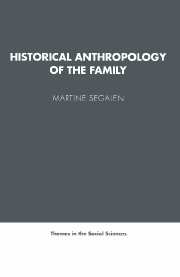Book contents
- Frontmatter
- Contents
- Foreword
- INTRODUCTION
- Part One The area of kinship
- Part Two The making of the domestic group
- Part Three Domestic roles and activities
- 7 ROLES WITHIN THE COUPLE IN THE NINETEENTH CENTURY
- 8 ROLES WITHIN THE PRESENT-DAY COUPLE
- 9 THE DOMESTIC GROUP AND ECONOMIC ROLES
- 10 FAMILY AND SOCIETY
- Notes
- Index
8 - ROLES WITHIN THE PRESENT-DAY COUPLE
Published online by Cambridge University Press: 14 January 2010
- Frontmatter
- Contents
- Foreword
- INTRODUCTION
- Part One The area of kinship
- Part Two The making of the domestic group
- Part Three Domestic roles and activities
- 7 ROLES WITHIN THE COUPLE IN THE NINETEENTH CENTURY
- 8 ROLES WITHIN THE PRESENT-DAY COUPLE
- 9 THE DOMESTIC GROUP AND ECONOMIC ROLES
- 10 FAMILY AND SOCIETY
- Notes
- Index
Summary
sociological role theories
Four theories, mostly Anglo-Saxon in origin and not directly transposable to French society, were very influential until history and social anthropology cast new light on studies of the family. They inspired a great deal of empirical research that provided the first corpus of quantitative data on these aspects of family life as well as material for current arguments about the development of intrafamilial roles in the context of the increasing numbers of women who work.
Parsons's theory of the separation of roles
This theory, which we have mentioned several times, is very useful in that it links family and social roles. That of the father is ‘instrumental’. He is responsible for contact with the outside world and is the economic provider. The mother's role is ‘expressive’, and she is responsible for all that is affective.
This model has only very infrequently corresponded to family practices. It has been violently criticised by feminists and recently destroyed by sociological analyses based on concrete cases, as Andree Michel has shown in Sociologie de la famille et du manage.
The network theory
The name of Elizabeth Bott is associated with the network theory, which she developed in Family and Social Network, linking the degree to which roles are separated to the density of the networks the spouses maintain outside the home. The closer their links with their networks of relatives, friends and neighbours and the denser these networks are, the more separate and hierarchical their relationship as a couple. The converse is also true: The less dense the networks, the less separate male and female roles will be.
- Type
- Chapter
- Information
- Historical Anthropology of the Family , pp. 223 - 256Publisher: Cambridge University PressPrint publication year: 1986

